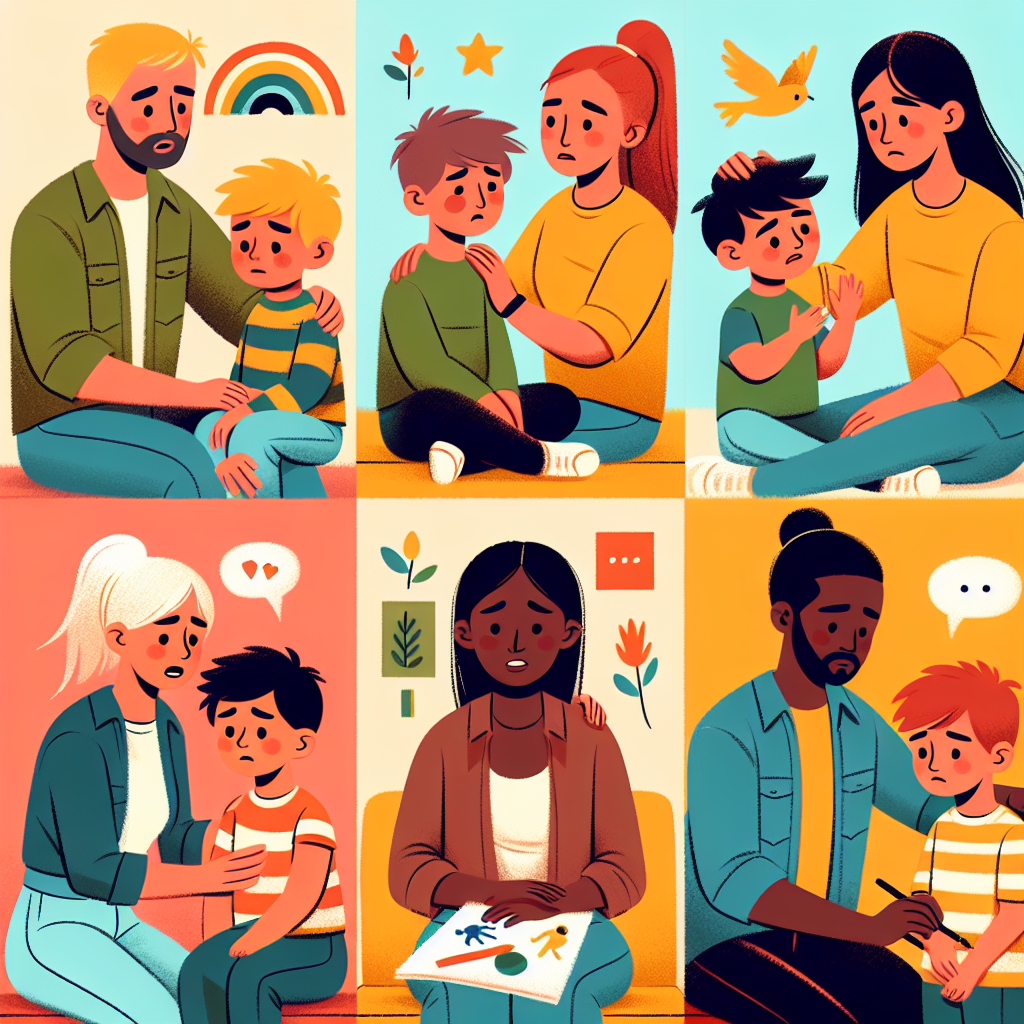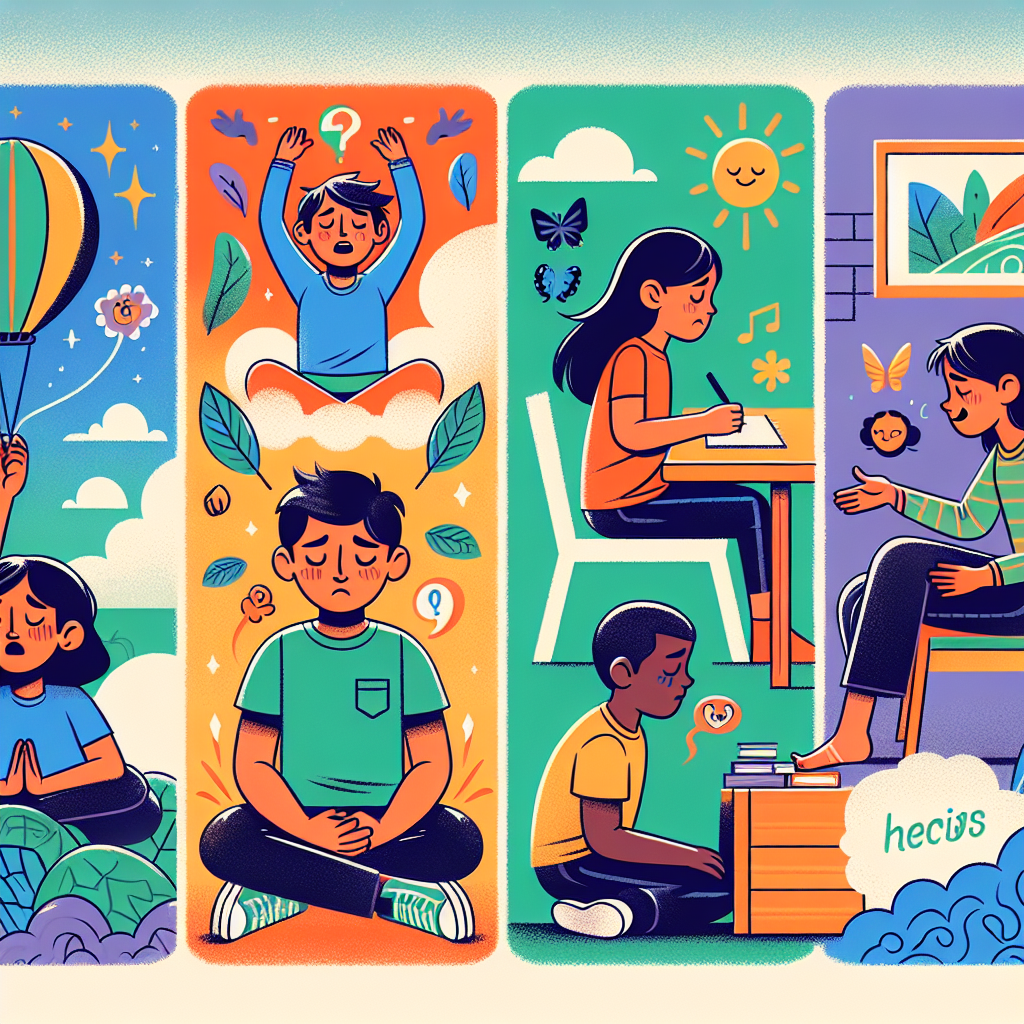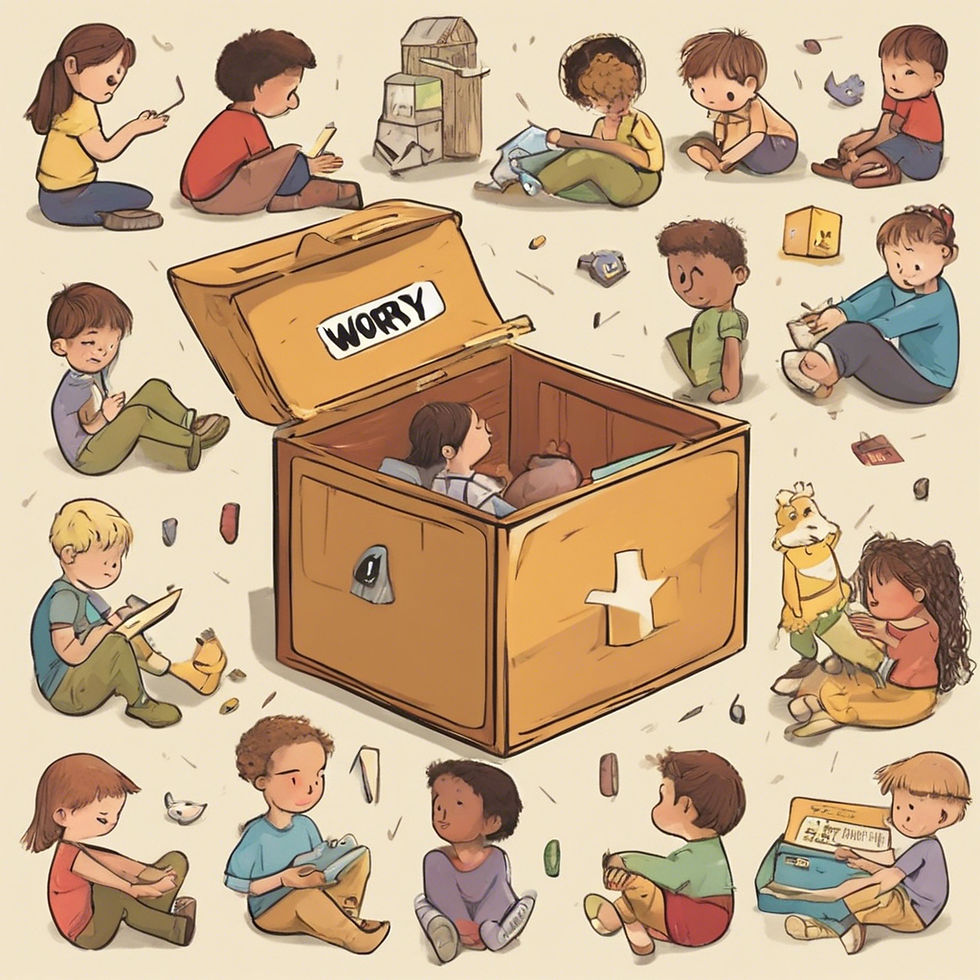Managing Worry in Children: 5 Strategies
- Jackie Archer

- Aug 19, 2024
- 11 min read
Updated: Nov 15, 2024
As we navigate the intricate world of raising children, one common challenge that often surfaces is helping our little ones deal with worry and anxiety. In this blog post, we'll explore 5 Effective Ways to Help Children Deal with Worry, fostering resilience and emotional well-being.
1. Encourage Open Communication

A key foundation in aiding children with worry is establishing a safe space for open communication. Encourage your child to share their feelings and concerns without fear of judgment. By actively listening and validating their emotions, you create a supportive environment where they feel understood and comforted.
At times, children may find it challenging to pinpoint and articulate their emotions, leading them to convey their feelings through actions rather than words. For example, when a child experiences feelings of anxiety or worry, these emotions may manifest in physical symptoms such as stomach aches, nail-picking, or a reluctance to go to school.
If your child is unsure of how they feel, you can encourage them to explore their feelings through a variety of other ways:
Play
Drawing
Creative activities
Metaphors / storytelling
By using this indirect method, children are encouraged to express themselves, which promotes emotional growth and enhances communication between parents and children. A great deal can be learned from your child through these techniques.
2. Teach Relaxation Techniques

We often believe that when children have “excess energy,” the best solution is to let them run around to tire them out. However, this approach can actually make the situation worse by overstimulating them further. In reality, what they need in those moments is slow, mindful activities to help calm their overactive minds.
Science shows that when children engage in calming activities, it activates their parasympathetic nervous system, which is responsible for relaxation and reducing stress. This shift helps to lower cortisol levels and soothe their brains, leading to better emotional regulation and a more peaceful state of mind.
Teaching children relaxation techniques can equip them with valuable coping mechanisms.
Techniques like deep breathing, mindfulness exercises, or simple yoga poses can help alleviate stress and anxiety.
Introducing these techniques in a fun and engaging manner can make them more accessible and enjoyable for children.
The 5 Senses Game

A simple and effective mindfulness activity for a child is the “Five Senses Game.” This activity helps children focus on the present moment by engaging their senses. Here’s how it works:
1. Get Comfortable: Have the child sit or stand in a comfortable spot. Encourage them to take a few deep breaths to relax.
2. See: Ask the child to look around and name five things they can see. It could be anything in their surroundings, like a tree, a toy, or a picture on the wall.
3. Touch: Next, ask them to focus on four things they can feel. This could be the texture of their clothes, the smooth surface of a table, or the warmth of the sun on their skin.
4. Hear: Now, have the child listen carefully and identify three sounds they can hear. It might be the sound of birds chirping, the hum of a fan, or their own breathing.
5. Smell: Ask them to notice two things they can smell. If they’re indoors, it might be the scent of soap, food, or fresh air coming through a window.
6. Taste: Finally, ask the child to focus on one thing they can taste. If they’ve recently eaten, they might still taste food, or they can just notice the neutral taste in their mouth.
Wrap-Up
Once they’ve gone through all five senses, you can ask them how they feel or what they noticed during the activity. This simple game helps ground children in the present moment, reducing anxiety and increasing their awareness of their surroundings. It’s a fun and calming way to practice mindfulness with kids.
5 Finger Breathing (Starfish Breathing)

What You Need: Just your hand!
How to Play:
1. Get Ready: Have the child hold out one hand, fingers spread wide, like a starfish.
2. Start Tracing: With the index finger of their other hand, ask them to start at the base of their thumb.
3. Inhale: As they slowly trace up the outside of their thumb, have them take a deep breath in.
4. Exhale: As they trace down the inside of their thumb, have them slowly breathe out.
5. Continue Tracing: Repeat this process for each finger. Breathe in as they trace up a finger, and breathe out as they trace down.
6. Complete the Starfish: Once they’ve traced all five fingers, they can either repeat the process or gently close their eyes and focus on their calm, steady breathing.
Why It Works:
• Physical Anchor: The physical act of tracing their hand gives the child something concrete to focus on, helping to anchor their attention.
• Mindful Breathing: Synchronizing the breath with the tracing movement encourages slow, deep breathing, which can calm the nervous system and reduce anxiety.
• Simple and Portable: This technique is easy to remember and can be done anywhere, making it a great tool for children to use whenever they need to calm down.
This game is an excellent way to teach children how to use their breath to center themselves, and the hand tracing adds a tactile element that makes it engaging and easy to practice.
Mindful Coloring

What You Need: Coloring sheets and crayons or markers.
How to Play:
• Give the child a coloring sheet and encourage them to focus on the colors and patterns as they fill in the spaces.
• Ask them to color slowly and notice how they feel as they pick each color and fill in each section.
• This activity promotes focus and helps the child stay present and engaged in a calming way.
Mindful Movement (Yoga Poses)

Here are some fun and simple mindful yoga poses that are perfect for kids:
Tree Pose
• How to Do It: Stand tall with feet together. Have the child shift their weight onto one foot and slowly lift the other foot to rest on the inside of the standing leg’s calf or thigh (avoid the knee). Have them bring their hands together in front of their chest like a prayer or raise them overhead like branches.
• Mindfulness Focus: Encourage the child to focus on their balance, imagining they are a strong, rooted tree swaying gently in the wind.
Cat-Cow Pose
• How to Do It: Start on hands and knees in a tabletop position. For Cat Pose, arch the back, tuck the chin to the chest, and look down. For Cow Pose, drop the belly, lift the chest, and look up.
• Mindfulness Focus: As they move between Cat and Cow, have the child coordinate their breath with the movement—inhale for Cow, exhale for Cat—focusing on the gentle flow of the spine.
Cobra Pose
• How to Do It: Have the child lie on their stomach with hands under the shoulders. They should press into their hands, lifting their chest off the ground, while keeping their elbows slightly bent and close to their body.
• Mindfulness Focus: Encourage them to feel the stretch in their back and chest, imagining they are a strong, wise cobra rising up to greet the sun.
Downward Dog
• How to Do It: Start on hands and knees, then lift the hips up and back, straightening the legs to form an upside-down “V” shape. Hands should be shoulder-width apart and feet hip-width apart.
• Mindfulness Focus: Have the child focus on their breath and the stretch in their arms and legs, imagining they are a playful dog stretching after a nap.
Child’s Pose
• How to Do It: Kneel on the floor, sit back on the heels, and stretch the arms out in front while lowering the forehead to the ground.
• Mindfulness Focus: Encourage the child to close their eyes and focus on their breath, feeling safe and relaxed like a little seed resting in the earth.
Butterfly Pose
• How to Do It: Sit on the floor, bring the soles of the feet together, and hold onto the ankles. Let the knees fall open to the sides, and gently flap the legs up and down like butterfly wings.
• Mindfulness Focus: Ask the child to imagine they are a colorful butterfly, focusing on the gentle movement and the sensation in their legs.
Lion’s Pose
• How to Do It: Kneel on the floor, sit back on the heels, and place the hands on the knees. Inhale deeply through the nose, then open the mouth wide, stick out the tongue, and exhale with a loud “roar!”
• Mindfulness Focus: This playful pose helps release tension. Encourage the child to focus on the powerful feeling of their roar and how it makes their body feel afterward.
Star Pose
• How to Do It: Stand with feet wide apart, arms stretched out to the sides. Have the child spread their fingers wide, making their body as big as possible, like a shining star.
• Mindfulness Focus: Encourage the child to take deep breaths and feel their energy radiating out like light from a star, spreading warmth and positivity.
Resting Pose
• How to Do It: Have the child lie flat on their back with arms by their sides, palms facing up. Ask them to close their eyes and relax every part of their body.
• Mindfulness Focus: Guide them through a body scan, encouraging them to relax from head to toe, focusing on the feeling of calm and stillness.
These yoga poses are not only fun and engaging for kids but also help them build mindfulness by focusing on their breath, body sensations, and the imagery associated with each pose.
Calm Down Box (Worry Box)

Creating a calm down box for children is a wonderful way to help them manage their emotions and self-soothe when they’re feeling overwhelmed, anxious, or upset.
Here’s a step-by-step guide to creating one:
1. Choose a Box
• Size and Material: Select a box or container that’s sturdy and easy to open, like a shoebox, plastic bin, or decorative storage box. It should be large enough to hold a variety of items but small enough for a child to carry.
• Personalize It: Let the child decorate the box with stickers, drawings, or their name to make it feel special and personal.
2. Fill It with Calming Items
Include a variety of sensory and emotional regulation tools that can help the child calm down.
Here are some ideas:
Tactile (Touch) Items
Stress Ball or Fidget Toy: Something squishy or textured that they can squeeze or manipulate.
Soft Blanket or Plush Toy: A comforting, soft item to hold or cuddle.
Playdough or Putty: Molding and shaping can be very soothing.
Weighted Lap Pad or Bean Bag: Provides grounding pressure that can calm the nervous system.
Visual Items
Calm Down Jar or Glitter Bottle: Watching the glitter slowly settle can be mesmerizing and calming.
Coloring Book and Crayons: Creative activities like coloring can help distract and soothe.
Soothing Pictures or Photos: Include images of favorite places, family members, or calming nature scenes.
Auditory (Hearing) Items
Music Player with Headphones: Pre-load with calming music or nature sounds.
Wind Chime or Bell: Soft sounds can be very soothing.
Olfactory (Smell) Items
Scented Lotion or Essential Oil: Lavender or chamomile scents can help with relaxation.
A Favorite Scented Object: Like a small sachet filled with dried flowers or a familiar scented item.
Emotional Support Items
Feelings Chart or Cards: Helps the child identify and express their emotions.
Notebook and Pen: For drawing or writing down thoughts and feelings.
Affirmation Cards: Positive messages or quotes that can help boost their mood.
Small Book: A favorite storybook or a short book about emotions.
3. Teach Them How to Use It
• Introduce the Box: Explain that the calm down box is there to help them feel better when they’re upset or need a break. Show them how to use each item and when they might want to reach for the box.
• Practice Together: Go through the items when the child is calm, so they’re familiar with how to use them. Role-play scenarios where they might need the box.
• Make It Accessible: Keep the box in a place where the child can easily access it whenever they need it.
4. Update the Box Regularly
• Check In: Periodically check with the child to see if the items in the box are still helpful or if they want to add something new.
• Seasonal Items: Consider swapping out items based on the season or any new interests the child may have developed.
5. Encourage Use
• Positive Reinforcement: Praise the child for using the calm down box to manage their emotions.
• Model Use: If appropriate, demonstrate using your own calming techniques alongside the child.
A calm down box is a great tool for helping children learn to self-regulate, providing them with a variety of strategies to find calm and comfort in challenging moments.
3. Establish Routine and Predictability

Consistency and predictability can provide children with a sense of security and stability, which can be particularly comforting for anxious children.
Establishing routines for daily activities, bedtime, and meals creates a structured environment that helps reduce uncertainty and worry.
Healthy Bedtime Routine Example
Creating a calming bedtime routine without screens can help children wind down and prepare for a restful night’s sleep.
Here’s an example of a screen-free bedtime routine:
1. Wind-Down Time (30-45 minutes before bed)
• Dim the Lights: Lower the lighting in the house to signal that bedtime is approaching.
• Quiet Play: Encourage activities like puzzles, building blocks, or coloring. These activities are engaging but not overly stimulating.
• Tidy Up: Have the child help tidy up their toys. This signals the end of the day and creates a sense of order.
2. Bath or Wash-Up (20-30 minutes before bed)
• Warm Bath: A warm bath is soothing and helps lower the body’s temperature afterward, signaling that it’s time for sleep.
• Brush Teeth: After the bath, help them brush their teeth.
• Pajamas: Let them choose their pajamas to make them feel involved and comfortable.
3. Calm Down (10-20 minutes before bed)
• Gentle Stretching or Yoga: A few simple stretches or child-friendly yoga poses can help release any remaining tension from the day.
• Bedtime Story: Read a favorite book or a calming story. Choose stories that are relaxing rather than exciting.
• Storytelling or Soft Music: If your child enjoys it, you can also tell a story from memory or play soft, calming music in the background.
4. Bedtime Rituals (5-10 minutes before bed)
• Gratitude Practice: Ask your child to name one or two things they’re grateful for from the day. This creates a positive mindset before sleep.
• Hugs and Kisses: Share some cuddles, hugs, and kisses to offer comfort and connection.
• Say Goodnight: If your child has a favorite stuffed animal or blanket, make sure it’s with them. Say goodnight to the room, the house, and anything else that helps create a peaceful atmosphere.
5. Lights Out
• Night Light: If your child prefers, leave a night light on. Choose one that emits a soft, warm glow.
• Leave the Room Quietly: After the routine, leave the room quietly. If your child struggles with separation, you can reassure them that you’ll check on them in a few minutes.
Additional Tips:
• Consistency is Key: Keep the routine consistent each night so the child knows what to expect.
• Avoid screen time at all costs!
• Avoid Sugar and Caffeine: Ensure your child hasn’t consumed sugary snacks or drinks with caffeine late in the day
.
• Create a Sleep-Inducing Environment: Make sure the room is cool, quiet, and dark, with a comfortable bed and bedding.
This routine helps create a sense of security and signals to the child that it’s time to transition from the busyness of the day to the peacefulness of sleep.
4. Promote Healthy Lifestyle Habits

Encouraging a healthy lifestyle for your child can significantly impact their mental well-being. Ensure they get enough sleep, engage in physical activity, and eat nutritious meals. Physical health and mental health are intricately linked, so fostering healthy habits can contribute to reducing anxiety levels.
5. Lead by Example

Children often learn by observing the behavior of adults around them. Model healthy ways of coping with stress and worry in your daily life. By showcasing resilience, problem-solving skills, and positive coping mechanisms, you provide a valuable template for your child to emulate when faced with their worries.
By implementing these five strategies, you can empower your child to navigate their emotions effectively and build resilience for the future. Remember, every child is unique, so feel free to adapt these tips to suit your child's individual needs and preferences.
So, the next time worry knocks on your child's door, you'll be armed with an array of tools to support them on their journey towards emotional well-being. Together, let's create a nurturing environment where worries are met with compassion and courage.
Let's embark on this meaningful journey of supporting our children through worry and anxiety management. Together, we can cultivate a thriving and resilient generation.
Here's to happy, worry-free little hearts!
For additional assistance and support with your child, feel free to contact Jackie for further guidance and assistance. You can find all the service details on the website.
Did you find this useful today?
Yes
Not Really



Comments